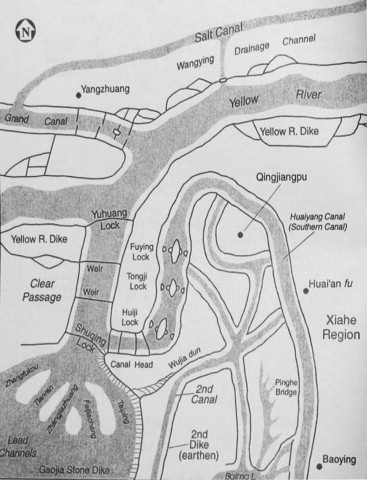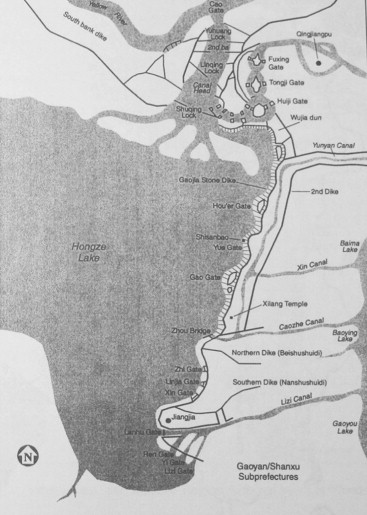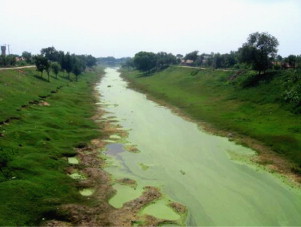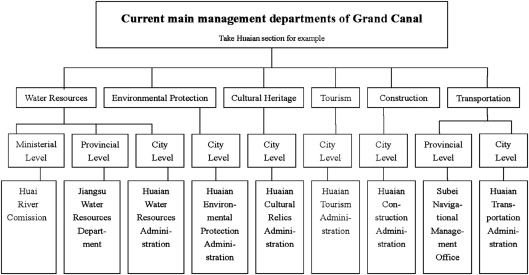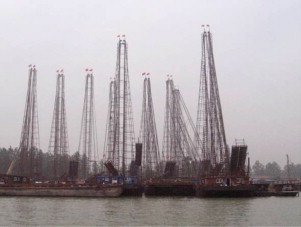Abstract
The Grand Canal is of incomparable importance to ancient China, which still serves its original functions in the current society. Given its outstanding value, the conservation of the Grand Canal in China is drawing an increasing attention, and there is a proposal to inscribe it in the World Heritage List in the near future. The different functions of the Grand Canal determine the roles of the different departments; however, there are some contradictions that will harm its conservation. The current paper attempts to find solutions toward the better management of the Grand Canal in the context of world heritage conservation.
Keywords
Grand Canal ; World heritage ; Management ; Conservation
1. Grand Canal, great job
The Grand Canal of China is widely regarded as the lifeblood for the governance of feudal China. It extends from Hangzhou, Zhejiang Province, in the south, to Beijing, in the north. The Canal connects five major rivers, including Qiantang River, Yangtze River, Huai River, Yellow River, and Hai River, and it flows through 35 cities. The expansion of canal communications helped ancient China accomplish the tasks of the military and meet the economic demand. The Grand Canal offered ample facility to transport food and goods from south to north in the early times. Just as importantly, it greatly improved the administration and defence of China as a whole, strengthening the economic and cultural intercourse between north and south, and contributing to the prosperity of the area along the route.
Historically, the Grand Canal was built in segments by many separated kingdoms starting some 25 centuries ago. Fuchai, the king of Wu, dug the first section named Hangou, which connected the Huai and the Yangtze rivers. The Sui Dynasty combined these segments together, when the need to link the capital at Luoyang to the key economic area of the lower Yangtze valley became imperative. The creation of an empire-wide canal system in the Sui-Tang period marked the culmination of a centuries-long process of experimentation in water-control engineering and management that enabled the Chinese state to achieve the strategic control and logistical integration of a greatly expanded empire. In the last decades of the 13th century, under the Yuan emperors, the same need remained. However, as the capital is now in Beijing, a vast remodeling of the canal was carried out, thus finally forming a continuous waterway following the 118th meridian in an S-shaped course from Hangzhou in the south to the farthest northern parts of the North China plain.
Canals needed to rise from one river valley and into the next to create networks that are able to facilitate the bulk carriage of cargoes across considerable distances. The Grand Canal was the first to do this.1 To adjust water levels from one terrain level to the next, the adjustable sluice gate was modified to function as a lock. The first recorded double-gate or pound lock in the world was built at the northern end of the Shan-yang Yun-Tao section between the Yangtze and Huai-yin in AD 984 by Chhiao Wei-Yo, the assistant commissioner of Transport for Huainan. In addition, Chinese canal builders also used the geographical contours and the water supplies of existing river systems to facilitate the construction of canals. The Grand Canal takes existing waterways on its route as much as possible, including the Yellow River. Every coin has two sides. Periodic flooding of the adjacent Yellow River threatened the safety and the functioning of the canal. Chinas topography, climate, and soil conditions conspired to take control of the Yellow River—with its silting, meandering, and flooding—a constant and unsolvable problem. Chinese attempts to control the Yellow River are almost as old as the Chinese civilization itself. The course of the Yellow River has changed nine times, in cycles of approximately 600 years, first flowing north of Shandong Massif and then to the south. From the later Han to the early Song period, the river followed a northerly course. From the late 13th to the mid-19th centuries (1288–1855), it followed a southerly course, usurping the bed of the Huai River. From the mid-19th century to the present, the river has reverted to the northerly course into the Bohai Gulf except for a brief period after 1937, when the dikes were intentionally destroyed to halt the advancing Japanese forces. Every time the Yellow River overflowed, the Grand Canal was influenced badly. From the experience of fighting with the Yellow River, many spectacular achievements have been achieved. The most popular one was the concept of Shu Shui Gong Sha (clearing sands with converging flow) proposed by Pan Jixun, the famous hydraulic expert of the Ming Dynasty (Fig. 1 , Fig. 2 ).
|
|
|
Fig. 1. Canal head and clear passage at the Grand Canal-Yellow River Junction (Fig. 1 cited from Leonaed (1996)Controlling From Afar the Daoguang Emperors Management of the Grand Canal Crisi, 1824–1826 . Michigan: Center for Chinese Studies The University of Michigan, Ann Arbor.). |
|
|
|
Fig. 2. Hongze Dike and drainage system and the Grand Canal-Yellow River Junction. |
Until today, the embankment of Hongze Lake exists as witness to this marvelous idea (Fig. 3 ).
|
|
|
Fig. 3. Current situation of embankment of Hongze Lake. |
Through the ages, the technology created for canal construction is impressive in its simplicity and efficiency. It was admirably suited to a canal system that relied, except for very large works, on local peasant communities for its maintenance and operation. It was also well suited to the multipurpose character of Chinas canal network, which had important subsidiary functions in irrigation and flood control. These attributes were noted with admiration by western travelers in the 17th and 18th centuries, who asserted that the efficiency of the system compared favorably to similar works in Western Europe at that time. Moreover, the basic technological innovations of the sluice gate, glacis, capstan, and winch, and the practical adaptations of basic canal designs remained the mainstays of Chinese canal engineering until the 20th century. If there was one feature in China that impressed the early modern European travelers more than any other, it was the great abundance of waterworks and canals.2
2. Functional heritage
The Grand Canal has gone through a glorious destiny from its beginning. Although it is always mentioned together with the Great Wall, the Grand Canal has never received as much attention in history as the Great Wall has, the Canal is infinitely more interesting and considerably more useful, even today. After the founding of the Peoples Republic of China, the massive dredging and construction of the Grand Canal continued, and new branches of canal have been dug up.
Now, some northern parts of the Grand Canal are polluted or impassable (Fig. 4 ), but many other parts are working waterways (Fig. 5 ) that are used primarily to transport vast amounts of bulk goods, such as bricks, gravel, sand, diesel, and coal, which annually shift three times more cargo than that moved by the rail between Beijing and the Lower Yangtze region. The Grand Canal is living, and greatly contributes to the development of society.
|
|
|
Fig. 4. Northern part of the Grand Canal. |
|
|
|
Fig. 5. Southern part of the Grand Canal. |
For example, during the snow disaster of 2008, 90 percent of the coal of Jiangsu Province was transported by the Grand Canal. The east route of the South-to-North Water Transfers takes the Grand Canal on its way. It is not only a site of heritage, but also a kind of waterway for transportation, that is, the Grand Canal is a kind of functional heritage.
In recent years, the conservation of the Grand Canal has drawn increasing attention. In 2004, at a conference held by the Chinese Peoples Political Consultative Conference National Committee, the director of State Administration of Cultural Heritage, Shan Jixiang, mentioned for the first time that the Grand Canal should be on the preparing list of the world heritage of China, which means the Grand Canal is being proposed to be included in the World Heritage List. This statement was made official in 2006, when the Grand Canal had been designated in the sixth batch of major sites to be protected at the national level. In a conference held by the State Administration of Cultural Heritage in Yangzhou in March 2008, it was declared that the groundwork for the application of the Grand Canal to be included in the said list started formally. From March to June 2008, the Chinese Cultural Heritage Research Academy and the Southeast University worked together to research the Guideline of the Conservation Planning of the Grand Canal . According to the Guideline, the Grand Canal cultural heritage sites comprise five parts: first, the engineering features of the canal itself—channels, retaining walls, wharves, locks, dykes, and bridges—and sites related to the infrastructure of the canal, such as government offices, granaries, and inns; second, the historical towns and villages that line the Grand Canal; third, the tangible structures of cultural heritage that line the Grand Canal, such as historical architectures, ancient tombs, temples, steles, and early modern and modern heritage sites; fourth, the landscape environment of the Grand Canal; and fifth, the intangible cultural heritage relating to the Grand Canal ( Guideline of the Conservation Planning of the Grand Canal, 2008 ).
3. Current management situation
As mentioned earlier, the Grand Canal remains a transport system, and the fact that it is a working system that sets it apart from other Chinese heritage sites. Heritage and tourism remain ancillary to the need expressed by most planners to improve the canal as a transport route. The integration of the Grand Canal with the South–North Water projects has also marked the Grand Canal as a unique cultural heritage area facing heightened threats. This means that the Grand Canal cannot be managed like the other common heritage sites in China. Aside from the Heritage Department, the Transport Department, Water Resource Department, Environmental Protection Department, and so on, are equally responsible for the Grand Canal, whose administrative targets are different from each other.
As for the Water Resource Department, the Grand Canal of transportation crosses three river basins—Huai River, Yangtze River, and Tai Lake. Considering flood control safety, three river basin commissions directly control hydrologic operation at the ministerial level. The River Basin Commission is the field office of the Ministry of Water Resources responsible for basin planning, coordination of water resources development, and integrated management, including flood control in basins, mediation of water disputes, and direct management of important projects in the two provinces. At the provincial level, like in the Jiangsu Province, the check gates and pumping stations are directly managed by the Jiangsu Water Resource Department, as the water affairs within a province is the responsibility of the provincial government. At the city level, the banks along the Grand Canal are managed by the water resource administrations of the different cities. The different divisions of the Water Resources Bureau are the water administration departments of the local governments, and are responsible for the planning, development, and management of water resources within their jurisdiction under the direct supervision of their local government counterparts. Understandably, the Water Resource Department manages the Grand Canal from top to bottom, and its main responsibility is to ensure the safety of the canal itself, its banks, and the riverbed.
As for the Transportation Department, its different sectors serve different functions. For example, the Navigational Sector is responsible for the construction and protection of waterways and navigation locks; the Transport Management Sector is in charge of the development of hauling capacity; and the Maritime Transportation Sector is responsible for the safety of transportation in the waterway, and the like. Particularly, in Shandong, Zhejiang, and south Jiangsu Province, the transportation department at the city level directly manages the transportation on the Grand Canal. Given the 10 navigational levels in the canal at the North Jiangsu Province, transportation thereat is managed by the Subei navigational management office, affiliated with the Jiangsu Transportation Department, to uniformly control these navigation locks. The Transportation Department manages the Grand Canal according to its different duties, and its main one is to make sure the unblocked transportation.
Aside from these two departments, still others are responsible for the Grand Canal, such as the Environmental Protection Department (responsible for the protection of the environment along the canal), the Tourism Department (charged with tourism development along the canal), and the Construction Department (responsible for construction along the canal). An example is the Huai'an section (Fig. 6 ).
|
|
|
Fig. 6. Current main management departments of the Grand Canal. |
Multi-department management will inevitably result in some conflict. Three kinds of conflict exist in the management of the Grand Canal.
4. Conflict among different departments
Among the different departments, the conflict between Water Resources and Transportation lasted for quite a long time, and even resorts to laws. Thus, for long-term partnership, the two departments set a cooperative system. The Transportation Department abides by the Water Resource Department on issues related to flood control, water drainage, and drought resistance; meanwhile, the latter keeps the waters navigable as a part of its responsibility. In reality, however, there are still some conflicts. Consider this example: Water Resource guidelines permit making profit from reusing the banks along the canal to shoulder maintenance costs; however, Transportation guidelines forbid the construction of plants or buildings that obstruct transport. Thus, because of different financial source, the local bank management department has to earn money by itself.
5. Conflict among departments and the local government
The Regulations of the Peoples Republic of China Governing the Administration of River forbid building, grazing, digging, burying, mining, and the like, on the lands protecting the banks. In fact, the management of the canal is concerned with many objectives, most of them are borne by government behavior and play important roles in local development. The interference of the local government hinders management efforts by the local water resource department.
On the other hand, the Rules of Implementation of the Peoples Republic of China Governing the Administration of Channel permit sand excavation in navigable rivers by the Water Resource Department and the Transportation Department, provided it does not worsen navigable conditions. In Luoma Lake in the Suqian section, sand excavation can be seen everywhere under the encouragement of the local government (Fig. 7 ).
|
|
|
Fig. 7. Sand excavation ships in Luoma Lake. |
Local residents say that the Zaohe town along Luoma Lake is already sinking because of long-term sand excavations. To develop the economy, the local government often builds wharfs along the canal as facilities for transporting goods and materials, even ignoring transportation guidelines.
6. Problems in the bid for inclusion in the World Heritage list
To prepare for its bid to be included in the World Heritage List in the near future, the Grand Canal must be managed according to the guidelines for world heritage sites, and must be monitored by the UN. Every department has expressed its willingness to support this bid. However, their efforts are subject to more rigorous management guidelines, such as the Guideline of the Conservation Planning of the Grand Canal , which stipulates that the rebuilding or expansion of the canal and the building of ports or wharfs must be approved by the Cultural Heritage department at the provincial level. Both the Water Resource and the Transportation departments say this will inconvenience their daily work.
7. Suggestions in the context of World Heritage
The bid for the Grand Canal to be included in the World Heritage List is not the only objective, but also its conservation and management. The current situation shows that the different roles of the Grand Canal determine its multi-department management. The Transportation Department cannot be responsible for flood control, and the Water Resource Department cannot act on behalf of the Cultural Heritage Department. Department-based decision making for the Grand Canal suffers from a major problem that managers make decision only within their own departments. This is not to say that the decisions made by each department are motivated by opportunistic behavior, and without dialogical justification. To better conserve and manage the Grand Canal, the first thing to do is establish an effective cooperative platform that allows sufficient communication and collaboration among the different departments, something they do not have at present. As the Operational Guidelines for the Implementation of the World Heritage Convention states: “Each nominated property should have an appropriate management plan or other documented management system which should specify how the outstanding universal value of a property should be preserved, preferably through participatory means. Collaboration is encouraged.” ( Operational Guidelines for the Implementation of the World Heritage Convention, 2008 )
Collaboration can be used effectively to resolve conflicts or advance shared visions, where stakeholders recognize the potential advantages of working together. Here, collaboration is a process of joint decision making among key stakeholders of a problem domain about the future of that domain. Freeman defines stakeholders as “any group or individual who can affect, or is affected by, the achievement of the organizations objectives.”3 All these related managerial departments can be regarded as a kind of stakeholder. There will be potential benefits when stakeholders collaborate and attempt to build a consensus on heritage conservation. Relevant stakeholders must realize these positive benefits to entice their participation. Collaboration “adds value” by building on the store of knowledge, insights, and capabilities of the stakeholders in the objective. Reaching a consensus through collaborative policy making involves a discursive process in which the participants learn about and respect each other and their differing viewpoints, reflect on their own viewpoint, work together with this combined “local knowledge” to establish a new discourse or story about the issues and the policy direction, and come to value and respond to the new policy direction.4 For example, the Transportation Department, Water Resource Department, and other departments responsible for the Grand Canal today should regard it as a site of heritage, not only as a kind of waterway. When making policy, the need to conserve heritage must be taken into account. Although it was recognized in the 1994 Canal Heritage Document that an element of the heritage of a canal is its evolution over the course of time, we should take care of the historical sites along the Grand Canal, whether they are historical towns or historical banks. Collaborations may be more successful if they include the stakeholders that are likely to be responsible for policy implementation. When the conservation plan of the Grand Canal is concluded, all related departments participating in policy making should carry it out, and monitor the whole process together.
Secondly, special laws and guidelines should be issued. Many kinds of laws are related to the Grand Canal. The major ones include the following: the Water Law of the Peoples Republic of China (1988) that was revised in 2002; Flood Control Law of the People Republic of China (1997) ; the Regulations of the Peoples Republic of China Governing the Administration of Channel (1987) that was revised in 2009; and the Law of the Peoples Republic of China on the Protection of Cultural Relics (1982) that was revised in 2002. However, as mentioned earlier, all are department-based laws, which cannot satisfy the demands of World Heritage. All the properties inscribed in the World Heritage List must have adequate long-term legislative, regulatory, institutional, and/or traditional protection and management as safeguards. Pursuant to the Law of the Peoples Republic of China on the Protection of Cultural Relics, the only law concerning cultural heritage, the necessary areas of protection along the Grand Canal should be restricted, and no construction of additional projects or such operations as blasting, drilling, and digging may be conducted within the protected area. The Grand Canal remains a transport system, above all, and the fact that it continues to be a working system sets it apart from other Chinese heritage sites. Hence, heritage must remain ancillary to the need expressed by most planners to improve it as a transport route, and to the view that construction thereon is necessary to better contribute to society. The first special regulation on the protection of the Great Wall, the Regulation on the Protection of Great Wall , was promulgated in 2006. However, the Grand Canal is much different from and more difficult to protect than the Great Wall, although they are often mentioned in the same breadth. The Grand Canal is such a vast cultural site with a large land area encompassing so many different regions. It is simultaneously cultural and natural, as well as static and dynamic. It consists of sites, lines, and fields that form an immense geographical corridor, and includes monuments of the ancient, early modern, and modern periods, as well as numerous historical cultural villages, examples of traditional housing, and invaluable items of intangible cultural heritage. Thus, to be included in the World Heritage List, special laws and regulations on the Grand Canal must be issued as soon as possible.
8. The role of the local government and the public
The local government program is considered the mainstay of the Heritage Incentives Program for three reasons. First, local government actions have a major influence on the historic environment (Sullivan, 2006 ) as a whole, through management of strategic planning at the local level and the day-to-day management of the historic environment. Second, they exert a major influence on the management of heritage items through the development assessment process. Third, as major owners of heritage sites, they can demonstrate leadership in best practice management of our rural and urban historic environments. Faced with the conflict between conservation and development, many local governments are inclined to development, not realizing that the Grand Canal plays such an important role in it. Thus, the role that local governments must play is important. Public participation is also very essential to the conservation of the Grand Canal. In western countries, the public, the community, or any other third party plays an increasingly critical role in policy decisions. The public owns the Grand Canal, and it is the public that can really conserve it. Through education and promotion, more and more members of the public will integrate conservation into their daily life. The conservation of the Grand Canal is everybodys duty.
References
- Flood Control Law of the People Republic of China, 1997 Flood Control Law of the People Republic of China, 1997.
- Freeman, 1984 R.E. Freeman; Strategic Management: A Stakeholder Approach; Pitman, Boston (1984)
- Guideline of the Conservation Planning of the Grand Canal, 2008 Guideline of the Conservation Planning of the Grand Canal, 2008.
- Healey, 1997 P. Healey; Collaborative Planning: Shaping Places in Fragmented Societies; Macmillan, London (1997)
- International Canal Monuments List, 1996 International Canal Monuments List, 1996.
- Law of the Peoples Republic of China on the Protection of Cultural Relics, 1982 Law of the Peoples Republic of China on the Protection of Cultural Relics, 1982
- Leonaed, 1996 J.K. Leonaed; Controlling From Afar the Daoguang Emperors Management of the Grand Canal Crisis, 1824–1826, Center for Chinese Studies The University of Michigan, Ann Arbor, Michigan (1996)
- Needham, 1971 Joseph Needham; Science and civilization in China; Physics and Physical Technology: Civil Engineering and Nautics, 4, Cambridge University Press, Cambridge (1971)
- Operational Guidelines for the Implementation of the World Heritage Convention, 2008 Operational Guidelines for the Implementation of the World Heritage Convention, 2008.
- Regulations of the Peoples Republic of China Governing the Administration of Channel, 1987 Regulations of the Peoples Republic of China Governing the Administration of Channel, 1987.
- Sullivan, 2006 Sullivan, S., 2006. Cultural Heritage and Local Government, Article Prepared for the 2006 Australian State of the Environment Committee. Department of the Environment and Heritage, Canberra.
- Water Law of the Peoples Republic of China, 1988 Water Law of the Peoples Republic of China, 1988.
Notes
1. International Canal Monuments List, 1996 . http://www.icomos.org/studies/canals-toc.htm .
2. Needham, 1971 . Science and civilization in China.Vol.4, pt.3, Physics and physical technology: civil engineering and nautics . Cambridge: Cambridge University Press. P 211.
3. Freeman, 1984 , Strategic Management: A Stakeholder Approach (Pitman, Boston) P 46.
4. Healey, 1997 . Collaborative Planning: Shaping Places in Fragmented Societies. London:Macmillan.
Document information
Published on 12/05/17
Submitted on 12/05/17
Licence: Other
Share this document
Keywords
claim authorship
Are you one of the authors of this document?
